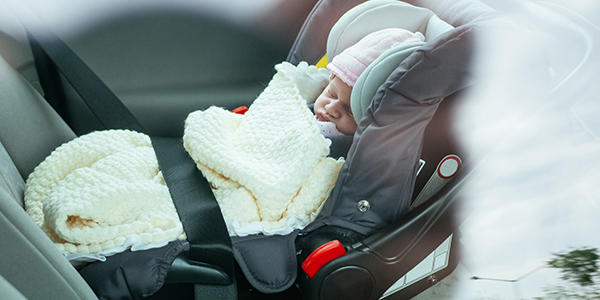Equipment Safety for Babies
Keeping Your Baby Safe Every Day
As a parent, your baby’s safety is always at the top of your mind. While you can’t protect your child from every bump or fall, there are many proven steps you can take to greatly reduce serious risks. From the car to the crib, small safety choices make a big difference in helping your little one grow and thrive.

Car Seat Safety: The First Line of Protection
Car accidents are one of the leading causes of death in babies and children, as well as a major cause of permanent brain damage, epilepsy and spinal cord injury. The good news? Most of these tragedies can be prevented with proper use of car seats.
A sudden stop at 30 miles an hour can hit a child’s body with the same crushing force as falling from a three-story building. That’s why California law (V.C. 27360) requires all children under 8 years old, or weighing less than 80 pounds, to ride in a federally approved child restraint system.
Car seat basics to remember:
- Never hold your baby in your lap, even for a short ride
- All children must ride in the back seat (if available) in a car seat until they’re at least 8 years old or 80 pounds
- Always use the correct car seat for your child’s age, weight and height. A 5-point harness is safest.
- Avoid infant carriers, travel beds or backpacks as substitutes for car seats
- Purchase new when possible. If using a second-hand car seat, make sure it hasn’t been recalled, doesn’t have damage, and is less than 6–10 years old.
- Never use a car seat that has been in a crash, even if there’s no visible damage California insurance companies are required to replace seats involved in accidents if the child was in them at the time
Rear-facing is safest.
- Babies under 1 year and under 20 pounds must ride in a rear-facing car seat
- After 20 pounds, transition to a convertible car seat that still faces the rear and is rated to at least 30 pounds
- Rear-facing seats should recline at a 45-degree angle
- Harness straps should be snug (room for only one finger at the collarbone), with the retainer clip at armpit level
- Your baby’s back and bottom should be flat against the seat, with straps coming from slots at or below the shoulders
Installation tips:
- Car seats should not move more than one inch side-to-side once secured
- Check your car’s owner’s manual to learn how seat belts lock, or if you’ll need a locking clip
- If both your car and car seat have the LATCH system, use it for easier installation.
- On hot days, check metal parts to prevent burns
- Don’t place your infant in the front seat with an active airbag. Children 12 and under are safest in the back.
If you’re unsure about installation, help is available. Certified Child Passenger Safety Technicians (CPS) can guide you, and many hospitals, public health departments, and law enforcement agencies offer free car seat check-ups. You can also call the NHTSA at 888-327-4236 or visit www.nhtsa.dot.gov for more information.
And remember: Never leave your child alone in the car, not even for a minute. Heat stroke, theft or other emergencies can happen quickly. California law (V.C. 15620) makes it illegal to leave a child under 6 unattended if the keys are in the ignition, the engine is running or the child’s health or safety may be at risk.
At Home: Everyday Safety Basics
Your home should feel like the safest place for your baby. With a few precautions, you can keep it that way.
Changing Tables
- Always keep one hand on your baby
- Keep sharp objects, creams, powders and lotions out of reach
- Avoid powders, perfumes or talcum products around babies
Crib Safety
Place your baby on their back to sleep, on a firm mattress in a crib that meets safety standards
- Crib slats should be no more than 2⅜ inches apart
- Avoid bumper pads, pillows, large toys and soft bedding
- Keep the mattress at the lowest position and side rails locked
- Check for sharp edges or chipped paint, and never use lead-based paint
- Don’t hang toys across the crib opening
High Chairs
- Always secure both waist and leg straps
- Keep high chairs away from stoves, cords and hot surfaces
- Inspect for sharp edges or rough spots
Infant Seats
- Use only sturdy, approved infant seats with safety straps
- These seats are not substitutes for car seats
- Never leave your baby unattended
Playpens
- Wooden slats should be no more than 2⅜ inches apart
- For mesh playpens, ensure clothing buttons are larger than the holes to prevent snags
- Check for sturdiness and sharp edges
- Always keep sides up when in use and supervise closely
Strollers and Walkers
- Make sure strollers lock firmly into position before use
- Avoid walkers, which increase the risk of accidents and delay healthy muscle development
Parenting comes with endless decisions, but safety doesn’t have to feel overwhelming. By using the right car seat, creating a safe sleep space, and checking your baby’s gear regularly, you’re already giving your child strong protection every day. And when in doubt, ask your pediatrician or reach out to local safety resources — support is always available.
Your careful attention today can help ensure your little one grows up healthy, happy and safe.
Care That Grows With Your Child
From checkups to sick visits and everything in between, our pediatricians are here to support your child’s health at every stage.




